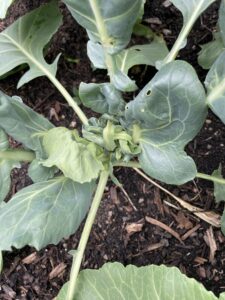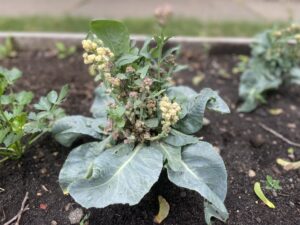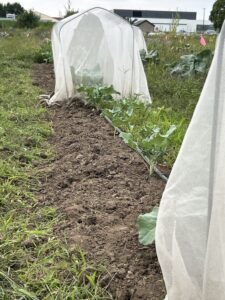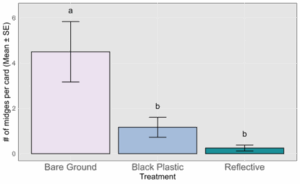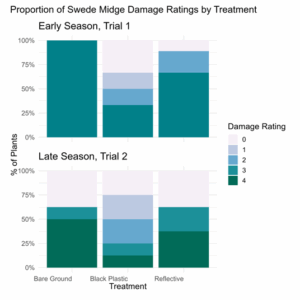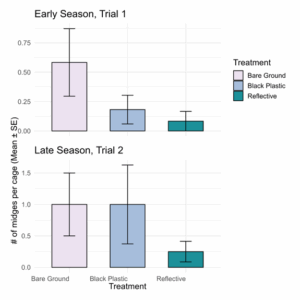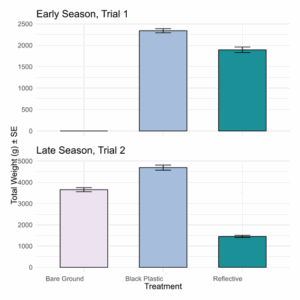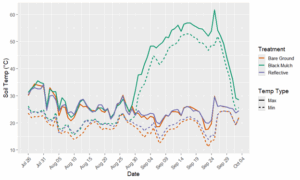Final report for GNC23-373
Project Information
Swede midge (SM) is an invasive insect pest that threatens organic production of brassica vegetables (Hodgdon et al., 2017). SM is a small fly that is difficult to identify and treat because physical symptoms are easily confused with herbicide damage and/or nutrient disorders. Initially, SM emerged on small-scale farms in the Northeast before spreading to commercial organic farms, where they have caused significant damage (Hoepting & Brake, 2020). Through surveys conducted in Minnesota, it was found that sustainable/organic growers have limited knowledge about this new pest, and it is either not a concern for them now or they are unaware of its existence. (C. Tong & M. Schuh, personal communication, 2022). However, SM has been reported on urban community gardens in the Twin Cities resulting in a decrease of the total number of brassicas planted (M. Gullickson, personal communication, April 7, 2022). In 2022, we monitored SM populations at 5 different locations and observed that insect population peaks occur in late-June, with a second peak occurring mid-August to mid-September. There is an urgent need to develop ecologically based management tools for control of SM in the Midwest before it reaches economic injury levels seen in Northeastern US. Currently, crop rotation is recommended but is not feasible on small farms. Therefore, because SM spends much of its life cycle in soil it is possible that early use of mulches can serve as a barrier preventing the second peak of SM, and lower subsequent populations. This study will investigate the effectiveness of black plastic, paper, and reflective mulches as possible SM management tools.
References
Hodgdon, E. A., Chen, Y. H., Hoepting, C. A., & Hallet, R. H. (2017). Organic Management of Swede Midge.
Hoepting, C., Brake, S. Vande, Cornell, C., & Program, V. (2020). Cornell Cooperative Extension Integrated Pest Management VEGETABLE FACT SHEET NEW Crop Rotation Recommendations for Swede Midge.
Learning outcome: Urban community gardeners will learn about the existence of SM including biology, the type of damage that it causes, timing of emergence of SM in the North Central region, about current methods of control and how to implement integrated pest management strategies. Project results will aid in educating urban community gardeners about the existence of swede midge and help them make choices that will prevent future crop damage. It will teach them how to monitor for SM damage. It will help gardeners learn what to do to prevent infestations. It will help urban community gardeners work towards lowering SM populations. Gardeners will feel confident to use these results to aid in selecting the appropriate mulch to control swede midge emergence as this will take the guess work out of the equation. Gardeners will select crops that are less susceptible to SM and practice appropriate pest management strategies.
Action outcomes: Urban community gardeners will learn IPM strategies and have less SM damage in their gardens. They will share this information with other gardeners. A survey will be conducted locally among urban community gardeners to determine if they implemented IPM strategies including mulching. Outreach efforts will also be measured via an online survey.
Research
Our initial objective was to evaluate the effectiveness of black plastic, cardboard, and reflective mulch as barriers to swede midge emergence. This cultural control practice has shown promise in conjunction with other IPM strategies at reducing swede midge populations in subsequent planting of brassicas. Our research questions were 1) To what extent do different mulches affect pupation and adult emergence of SM?, and 2) Does the mulch act as a physical barrier preventing access to the soil for pupation? To answer these questions, we ran a series of trials in the greenhouse, followed by two field trials in May and July 2024. These experiments are described below.
Materials and Methods
Insect Colony
An endemic colony of swede midges was established at the Plant Growth Facilities at the University of Minnesota. Beginning in late May 2024 swede midge eggs and larvae were collected at two community gardens in Saint Paul. 4 to 6-week-old sentinel cauliflower plants (Brassica oleracea var. Botrytis) were grown from organic ‘Snow Crown’ F1 seeds (Johnny’s Selected Seeds, Winslow, ME, USA), and were strategically planted in areas of known swede midge infestations where adult midges laid eggs for 1 to 2 weeks, and replaced throughout the growing season. Infested plants were collected and transported to a greenhouse and placed inside a 15.7” x 15.7” x 23.6” pop-up insect meshed cage (Restcloud, China) where the insect completed their life cycle, i.e., eggs matured into larvae, larvae matured and dropped to the soil for pupation, and the next generation of adults emerged. Swede midge was positively identified via morphological characteristics, using a Leica dissecting microscope (Leica Microsystems, Wetzlar, Germany). New sentinel plants were added to the cages every 1 to 2 weeks. In addition, fresh 4 to 6-week-old cauliflower plants grown in a greenhouse were placed into cages 3 times per week, where newly emerged and mated midges could complete their life cycle.
Greenhouse Studies
Mulches to prevent larvae access to the soil for pupation. In our initial proposal, we intended to test cardboard mulch; however, we eliminated it due to not having organically approved material for this project. We tested black and reflective plastic mulches to compare against a bare ground control. We then ran a total of 5 trials to answer the question, ‘Can mulches disrupt the life cycle of the swede midge by reducing larval survival and preventing access to the soil for pupation?’
The experiment was set up in a completely randomized design, with four replicates per mulch treatment. Each experimental unit consisted of the following: 12” W x 12” L x 12” H pop-up insect meshed cage (RestCloud, China), with a black plastic 12-inch diameter pie pan (T.O. Plastics, North America), Lambert LM-ORG organic growing mix, a peat-based substrate composed of sphagnum peat moss, perlite, and compost (Lambert Peat Moss Inc., Riviere-Ouelle, QC, Canada), a cauliflower plant, and appropriate treatment. Thirty-seven 9-day-old late instar larvae or pre-pupae were carefully selected with a pre-moistened fine-tipped paintbrush and placed on the growing point of 4-week-old plants. Each trial ran consecutively for ten to twelve days, starting one week apart. After 7 days, 3” x 3” pre-cut double-sided yellow sticky cards were placed on metal clips on stands at the base of the plant, and the number of adults was counted daily for 12 days. We hypothesized that the mulch treatments would equally prevent larvae access to the soil for pupation, thereby reducing subsequent generations.
Mulches to prevent the emergence of new swede midge adults from the soil. For this set of greenhouse trials, we aimed to test the effect that mulches had on preventing the emergence of new adults from the soil. We used 10.94" W x 21.44" L x 2.44" D, 1020 no-hole trays (T.O. Plastics, North America) and planted a ‘Snowcrown’ cauliflower seedling on one side and then dispersed 10-day-old larvae on the opposite end of the tray, ~50 cm. We ran 3 consecutive trials with bare ground as the control, black, and reflective plastic as the treatments, with 4 replicates per treatment. Seven days after infestation, 3” x 3” cut-out yellow sticky cards (Olson Products, Inc., Medina, Ohio) were placed at the plant canopy, and midges on cards were counted 21-30 days later. Air and soil temperature sensors were placed in individual cages at the beginning of each trial to assess potential impacts of temperature on emergence. We hypothesized that the mulch treatments would prevent the emergence of swede midge adults from the soil because of the distance from the planting hole.
Analysis of adult emergence was performed using R (4.4.2., R Core Team, R Foundation for Statistical Computing, Vienna, Austria) using a negative binomial regression with number of adults who emerged per sticky card as the dependent variable, and mulch type as the independent variable, using the MASS, dplyr, and tidyverse packages.
Field Studies
In 2024, early and late planting trials were conducted on certified organic land previously infested with swede midge at the University of Minnesota’s Saint Paul campus. The description here is true for both trials, with differences stated in the following sections, ‘early planting’ and ‘late planting.’ The side-by-side plots each measured 60’ by 45’ and were divided into 12 rows. The rows were 3’ wide with 2’ spacing. Each trial was set up in a split-plot design, with 4 blocks, 3 treatments per block, 3 replicates per treatment for a total of 12 replicates per block and a total of 36 replicates. Each replicate was a cage consisting of a 7’ by 7’ 80 g ProtekNet (Dubois Agroinovation, Quebec, Canada) draped over two 24” aluminum hoops with the edges of the fabric buried into the soil. We were careful to ensure that no soil remained uncovered within the cages on top of mulch treatments.
Field beds for both trials were tilled and shaped, and the mulches were placed on May 5, with organic clover sown in between the rows. We initiated a soil test before planting to determine fertilization needs, and a 13-0-0 organic feathermeal amendment was added when transplanting. The early trial was planted in May, and the late trial was planted in July. The effect of black and reflective plastic mulches compared to bare ground on swede midge emergence, crop damage, and marketable yield of ‘Belstar’ F1 organic broccoli (Johnny’s Seeds) was measured. We seeded ‘Belstar’ broccoli in a greenhouse approximately 5 weeks before the intended transplant date.
We evaluated black and reflective plastic mulches as ground barriers for swede midge emergence and asked the following research questions.
- Do the black and reflective plastic mulches act as physical barriers preventing larvae access to the soil for pupation?
- Do the mulches lessen plant damage caused by swede midge?
- How does the mulch affect marketable crop yield?
All analyses were conducted in R. Damage ratings were analyzed using a cumulative link mixed model (CLMM) ordinal logistic regression with a random intercept for block, damage rating as the outcome variable, and treatment as the predictor. Adult emergence and marketable yield were analyzed using non-parametric tests.
Early Planting. Seedlings were transplanted on May 10 with 18” spacing and replaced as needed for up to 1 week. In these cages, we grouped 3 eight-week-old plants and introduced 10 female and 10 male midges from our lab colony. One week later, 6” by 6” yellow sticky cards were added to each cage within the plant canopy to collect emerging adults. Plants were collected 21 to 30 days later, and adults on cards were counted to assess emergence rates. To evaluate how these mulch treatments influenced crop damage, we used a 5-point swede midge damage rating scale (Fig. 2) developed by researchers at Cornell Cooperative Extension - Cornell Vegetable Program (Hoepting, 2019), starting on 17 June and continuing every 2 weeks thereafter until harvest. Finally, we recorded market fresh weight to assess if black or reflective mulch affected vegetable quality.
Late Planting. Seedlings were transplanted on July 18. We increased plant spacing to 24” and reduced the density to 1 plant per cage. In the first trial, using 3 plants per cage led to overcrowding, which made it difficult to accurately assess damage ratings and may have contributed to lower marketable fresh weight. Instead of infesting three cages per row, we chose to infest two and use the third cage to monitor for natural infestation, resulting in 24 experimental replicates. Five days after infestation, one 3” x 5” yellow sticky card and one 3” x 5” white sticky card (Alphascents.com Canby, Oregon) were placed within the plant canopy to capture emerging swede midge flies. We used smaller cards in this trial because the larger cards used in the first trial were frequently blown down by the wind. The white cards were added to align with the white sticky card inserts commonly used in swede midge Jackson traps.
In addition to the previous research questions, for this trial, we also wanted to assess the effect that the mulches had on soil temperature, and added the following research questions.
- Do mulches reduce or increase soil temperature?
- How does this affect market fresh weight?
- Does the temperature get hot enough to potentially kill swede midge in the soil?
HOBO Pendant Temp/Light, 64K sensors (Onset Computer Corporation, Cape Cod, Massachusetts) were buried just below the soil surface (~5 cm), inside and outside of the treatment cages, and recorded temperature data hourly throughout the trial period. Outside temperatures were collected from the Saint Paul weather station data. Individual crop damage ratings were collected from the treatment cages and 10 random field plants per row beginning on August 2, and then continuing every 2 weeks until harvest. Market fresh weight was collected from treatment cages on 9/26. There was no marketable yield for vegetables outside of cages due to high swede midge pressure outside of treatment cages.
Greenhouse. A negative binomial regression model was fitted using treatment as a predictor. When assessing if black and reflective mulches would prevent larvae access to the soil for pupation, we observed a marginally significant (p = 0.0857) reduction of 0.95+/- SE % in adult emergence with black mulch treatment relative to the bare ground control (data not shown). However, when assessing if mulches prevented new adult swede midge from emerging from the soil, both black and reflective mulches significantly reduced emergence compared to the bare ground control (Fig. 1). The black plastic mulch treatment resulted in a significant reduction in adult counts (p = 0.007), and reflective mulch had an even stronger effect (p < 0.0001) (Table. 1). Overall, these results suggest that midges cannot successfully emerge when they are ~50 cm from a planting hole.
Table 1. Effect of Mulches to Prevent Emergence of New Swede Midge Adults from the Soil. Mean (± SE) number of adults captured per treatment cage. Letters denote significance at α = 0.05.
|
Treatment |
# Adults on Sticky Card (Mean ± SE) |
|
Bare Ground |
4.5 ± 1.33 a |
|
Black Plastic |
1.17 ± 0.44 b |
|
Reflective Mulch |
0.25 ± 0.13 b |
Fig. 1. Effect of Mulches to Prevent Emergence of New Swede Midge Adults from the Soil.
Bar plot with standard error of the mean of the number of adult midges that emerged per cage per treatment.
Field Studies
Damage Ratings. A CLMM ordinal logistic regression with a random intercept for block was used to evaluate the effect of mulches on plant damage caused by swede midge (Table 2). In the early planting, 100% of plants in the bare ground treatment had the highest damage rating (Fig. 2, Early Season, Trial 1), and both black (p < 0.001) and reflective (p < 0.001) mulch treatments significantly reduced the average damage ratings compared to bare ground. In the late planting, lower damage ratings were also found for black (p = 0.38) and reflective (p = 0.78) treatments compared to the control, but not significantly.
Table 2. Cumulative link mixed model (CLMM) results for the effect of treatment on plant damage ratings in Early (trial 1) and Late (trial 2) Planting Field Trials.
Models included a random intercept for block and used ordinal logistic regression.
|
Trial |
Treatment |
Coefficient |
Std. Error |
t-value |
p-value |
|
1 |
Black Plastic |
-22.12 |
1.233 |
-17.94 |
<0.001 |
|
|
Reflective Mulch |
-20.52 |
1.273 |
-16.12 |
<0.001 |
|
|
Random Effect (Block) |
Variance = 1.719 |
Std. Dev. = 1.311 |
|
|
|
2 |
Black Plastic |
-0.8203 |
0.9268 |
-0.8851 |
0.376 |
|
|
Reflective Mulch |
-0.2685 |
0.9694 |
-0.2770 |
0.782 |
|
|
Random Effect (Block) |
Variance ≈ 0 |
Std. Dev. ≈ 0 |
|
|
Note: Negative coefficients indicate a reduction in damage rating relative to the reference level (bare ground). P-values for Trial 1 were calculated using Wald z-tests. Trial 2 showed no significant treatment effects.
Fig. 2. Distribution of Swede Midge Damage Ratings by Mulch Treatments Across Both Trials.
Stacked bar plot showing the distribution of swede midge damage ratings (0 = healthy; no damage, marketable, 1 = minor damage; plant unaffected, marketable, 2 = moderate damage; plant quality and/or yield reduced, marketable, 3 = major damage; remnants of growing point, not marketable, 4 = severe; blind head, not marketable)
Emergence. For both trials, reflective mulch demonstrated a trend of reduced emergence compared to the bare ground treatment (Fig. 3). For the early planting, a Poisson Regression model with the predictors, mulch as fixed effect and block as random effect, for adult emergence, determined that reflective mulch had a marginally significant effect (p = 0.07) on suppressing swede midge emergence compared to bare ground control, and while black mulch also reduced midges it did not do so significantly. For the late planting, we ran a negative binomial regression, and there were no significant differences across treatments.
Fig. 3. Impact of Mulches on Swede Midge Emergence in Field Trials. Bar graph with error bars
representing standard error of the mean showing the number of adult swede midges observed on sticky cards across three treatments. Statistical analysis indicated that reflective mulch treatment may reduce emergence, but there is no statistical significance.
Marketable Yield. To compare the marketable yield across treatments, we analyzed data using a linear mixed model with treatment as the fixed effect, and block and ‘block x treatment’ as random effects (data not shown). The black mulch treatment yielded higher fresh weight per cage and the highest yield overall in both trials (Fig. 4). For the early planting, black and reflective mulch significantly increased market fresh weight (grams) compared to the control, but there was great variation between blocks. In the late planting, neither mulch treatment significantly increased yield compared to the control, because in this trial, the bare ground yield was much higher.
Fig. 4. Impact of Mulches on Marketable Fresh Weight of Broccoli. Bar graph with error bars
representing standard error of the mean showing the total yield across two trials and all treatments.
DISCUSSION
Effective swede midge management requires a multi-pronged approach. Swede midge has multiple generations, and populations will increase throughout a growing season if farmers practice sequential cropping (Hodgdon et al., 2024). Therefore, later plantings of brassicas may be more at risk. Temperature greatly influences pupal development and adult survival, with pupal development decreasing between 10°-15℃, and adult longevity increasing to ~19.7 d at 5℃ and decreasing to ~ 1.7 d at 35℃ (Liu et al., 2019). Preliminary greenhouse trials showed that using mulches significantly reduced adult emergence when the transplants were placed ~50 cm away from the site of emergence, but further investigation is needed to determine if the reduction is due to their inability to escape via the planting hole due to distance, or if it is due to a combination of distance and soil temperature.
In the summer field trials, we planted two successions of broccoli on previously infested land, which affected the accuracy of our data for both trials. In the early season, overwintered swede midge emerged inside our treatment cages shortly after they were set up. By the time we established the late season in July, the overwintered midges had already emerged, meaning that little or no natural emergence occurred within those cages. Additionally, our attempt to artificially infest cages using our colony-reared flies may have been unsuccessful, as the flies could have either died or failed to lay eggs.
For the early season, high swede midge pressure, from both natural emergence and artificial infestation, contributed to zero marketable produce in the bare ground control based on the average plant damage rating of 4 (Fig. 2). However, it is difficult to determine whether swede midge pressure alone had any role in marketable yield in the late season planting. In the late planting, black mulch demonstrated a steep increase in maximum and minimum soil temperatures compared to bare ground and reflective mulch (Fig. 5). Importantly, increased soil temperature can lead to a 100% yield increase for broccoli (Rykbost et al., 1975). Black mulches are used to warm the soil in early spring and increase early yield of tomatoes, meanwhile white and reflective plastic mulches are typically used to cool soil temperature (Tarara, 2000). This is reflected in our data for both early and late planting, which demonstrates that black mulch had a higher yield, whereas reflective mulch yield decreased (Fig. 4).
Results of the emergence analysis for the early planting suggest that mulches may help prevent swede midge emergence. However, it is important to note that these results are explicitly for experimental units protected with exclusion netting, i.e., they were in cages that protected them from continuous natural infestation from midges emerging in other parts of the field that were not covered by mulches or netting.
Fig. 5. Maximum and Minimum Soil Temperatures During Late Season, Trial 2. This line
graph shows soil temperature trends over time for each treatment. HOBO Pendant Temp/Light, 64K sensors were buried just below the soil surface (~5 cm) and recorded temperature data hourly throughout the trial period. Black mulch demonstrates a dramatic increase in both maximum and minimum soil temperatures compared to the bare ground control and reflective mulch treatment.
Swede midge remains a challenging pest to manage due to its small size and hidden feeding behavior within plant tissue. In greenhouse trials, black plastic mulch did not significantly reduce adult emergence in the first round; however, in the second round, when plants were placed ~50 cm from the site of emergence, black mulch significantly suppressed emergence. In the field, black mulch reduced emergence in the early planting but not in the late planting. Nonetheless, our findings indicate that black plastic mulch has the potential to interrupt the life cycle and to raise soil temperatures beyond the developmental thresholds of swede midge pupae, making it a promising tool when utilized with other IPM tools.
Educational & Outreach Activities
Participation summary:
2024
Organic Fruit and Vegetable Field Day - July 2024
2025
Minnesota Organic Conference - January 2025
Project Outcomes
This project served as an educational tool that informed local urban gardeners about the presence of swede midge, the type of damage caused, and potential prevention techniques.
Swede midge is an invasive pest that is difficult to manage. Preventing damage will likely require a combination of pest management techniques, such as crop rotation, fabric or plastic mulch, and exclusion netting.
